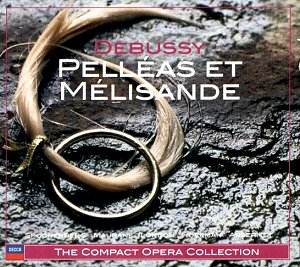Pelléas
et Mélisande has fared variably on record. Whether pushed
to the extremity of post-Wagnerian lushness by Karajan in 1988,
anatomised with a clinician’s eye by Boulez or conducted with
authentic French clarity by Desormière nearly half a century
earlier, one can experience some polarised interpretations. Few
however have the stature and authority of Ansermet’s two recordings
– he never lived to conduct the third he hoped to make - one dating
from 1951 and this Decca from 1964. There is a great deal to say
– about his astuteness with regard to string weight, his complex
understanding of character, his infallible sense of theatrical
moment, his acute unfolding of colour in this score – and also,
paradoxically, very little to say, so profoundly indivisible is
Ansermet’s conducting from Debussy’s textual and visual implications.
Camille
Maurane is Pelléas and was middle aged when he came to
record the role but you wouldn’t know it; the voice is excellently
preserved and employed with discretion and unerring distinction.
His Mélisande is Erna Spoorenberg. For Ansermet’s 1951
recording he had Pierre Mollet and Suzanne Danco but though distinguished
names they are certainly not superior to Maurane and Spoorenberg
– she is exceptionally adept and impressive. The equally strong
Golaud is George London who serves notice from his earliest appearance
and then mightily at the beginning of Act II Scene II – Ah!
Ah! Tout va bien, cela ne sera rien – of the eruptive presence
in one’s midst. Guus Hoekman is Arkel and his is an aristocratic
assumption without overstepping the bounds of the role – he never
forces through the tone and remains sympathetic throughout. There’s
an especially impressive performance from Rosine Brédy
whose Yniold is truly memorable – aptly youthful with a splendid
range. In the subsidiary roles we find two venerable British singers
in the earlier days of their careers- John Shirley-Quirk (The
Doctor – a tiny role) and Josephine Veasey as Geneviève,
maybe not quite as idiomatic as Jeannine Collard (for Cluytens
in 1957) but still good.
The
orchestra was one of Europe’s more unpredictable ensembles, living
up to the lines "When they were good they were good, when
they were bad…" Here they are on excellent form; one only
has to listen to the way Ansermet encourages some lustrous string
tone in the Interlude between Scenes II and III in the First Act
to know that they were inspired by the event and were notably
well drilled as well. As a result the opera evolves with a pretty
perfect balance between technical excellence and expressive refinement.
For this of course most of the cachet belongs to Ansermet – though
cachet is a cheap word for so fluid and knowledgeable a conductor,
whose experience was plain for all to hear. The recording stands
the test of time; Decca used some reverberation in the Castle
scenes but otherwise the clarity, which is never coldness, is
appropriate for this most static and verbal of operas. The booklet
prints a synopsis in English, French, German and Italian – but
there is no libretto.
Jonathan
Woolf
